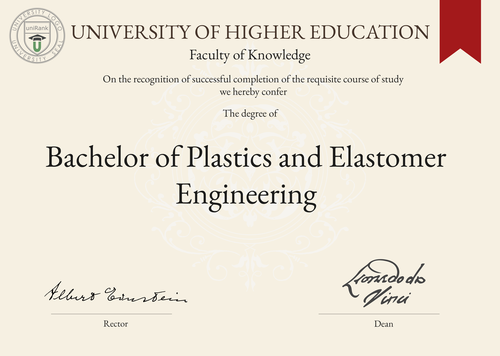
Bachelor of Plastics and Elastomer Engineering (BPEE)
Guide to Bachelor of Plastics and Elastomer Engineering Program/Course/Degree
Bachelor of Plastics and Elastomer Engineering (BPEE)

Program Name:
Bachelor of Plastics and Elastomer EngineeringProgram or Degree abbreviation:
BPEEDuration range:
The duration of the program typically ranges from 3 to 4 years.Tuition range:
The tuition fees for the program can vary depending on the country and university chosen. It is recommended to check with specific institutions for accurate information.Overview:
The Bachelor of Plastics and Elastomer Engineering program is designed to provide students with a comprehensive understanding of the materials, processes and technologies involved in the field of plastics and elastomers. Students will gain knowledge in areas such as polymer chemistry, material properties, processing techniques, product design and quality control.Curriculum Overview by year:
- Year 1: Introduction to Plastics and Elastomers, Mathematics for Engineers, Chemistry Fundamentals, Engineering Drawing, Introduction to Engineering Design. - Year 2: Polymer Science, Material Testing, Thermodynamics, Polymer Processing, Engineering Mechanics. - Year 3: Polymer Characterization, Polymer Product Design, Polymer Processing Machinery, Polymer Composites, Industrial Training. - Year 4: Polymer Rheology, Polymer Recycling, Advanced Polymer Processing, Research Project, Elective Courses.Key Components:
- Polymer Chemistry and Material Science - Polymer Processing Techniques - Product Design and Development - Quality Control and Testing - Industrial Training and InternshipCareer Prospects:
Graduates of the Bachelor of Plastics and Elastomer Engineering program can pursue various career opportunities in industries such as automotive, aerospace, packaging, medical devices and consumer goods. Possible job roles include plastics engineer, materials engineer, product development engineer, quality control engineer and research scientist.Salary Expectations:
The salary expectations for graduates of the program can vary depending on factors such as the country, industry, job role and level of experience. It is advisable to research specific salary ranges in the desired location and field. For a more accurate understanding of salary expectations, you can utilize the Job Sites Search Engine, from our sister site jobRank, which searches over 4,600 job sites worldwide. Make sure to specify not only the job title but also the country you are interested in.Conclusions:
It is important to note that the duration, tuition fees, curriculum, key components, career prospects and salary expectations of the Bachelor of Plastics and Elastomer Engineering program can vary based on the chosen country or location for studying the program, as well as the chosen university. Prospective students are encouraged to explore different universities and countries to find the best fit for their educational and career goals. Visitors can search for institutions offering the Bachelor of Plastics and Elastomer Engineering program worldwide through the uniRank World Universities Search Engine.World Universities Search Engine
search for Bachelor of Plastics and Elastomer Engineering (BPEE) and add the Location (country, state etc.) or specific University you are interested in studying at.
Query examples:
- Bachelor of Plastics and Elastomer Engineering (BPEE) United States
- Bachelor of Plastics and Elastomer Engineering (BPEE) United Kingdom online
- Bachelor of Plastics and Elastomer Engineering (BPEE) Australia international students
- Bachelor of Plastics and Elastomer Engineering (BPEE) University of California
- Bachelor of Plastics and Elastomer Engineering (BPEE) University of London tuition fees
- Bachelor of Plastics and Elastomer Engineering (BPEE) University of Sydney scholarships
Share Program/Course
Interesting? Share this program/course/degree info with your friends now.